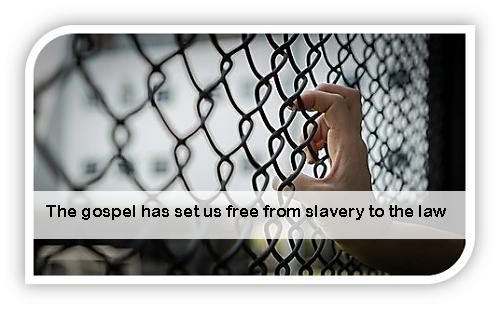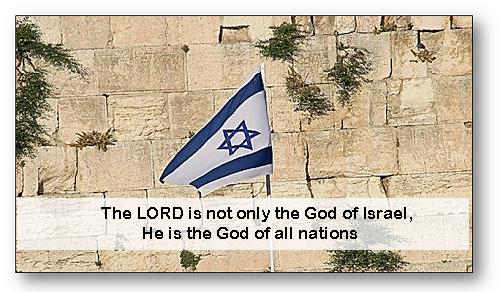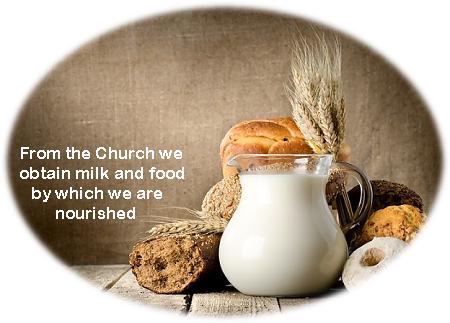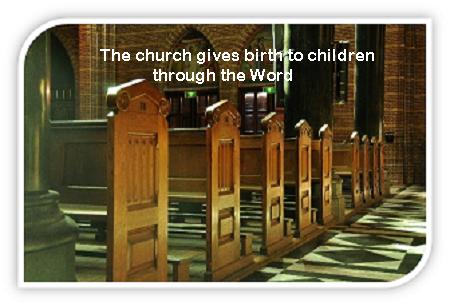The Mission of a Mother
The Mission of a Mother

Dogmatic reflection is not academic gymnastics for the brain, but is important to the life of the church. The validity of this conviction can be made clear by looking at the doctrine of the church. The subject matter for which I am asking your attention is the missional character of the church. During the past century a great deal was written and said on this issue. I merely refer to the work of J.C. Hoekendijk, who was so convinced of the fact that the church is only an instrument with respect to its calling of service to the world, that he felt the church ought to be turned inside out. The church is no more than a function of the apostolate.
Motivated by a deep conviction, others have likewise asked attention for missional aspects of being church. They were convinced that established churches fell short on this point, in that mission had become or remained too much of an appendix to the church. I think of the work of men such as Hendrik Kraemer and Lesslie Newbigin who, during the last fifty years emphatically pointed out that the church must give evidence of a missional attitude in its whole being. Nevertheless, it was not until the close of the last century that orthodox Reformed churches in The Netherlands clued in to this missional aspect of being church. Church projects in which the missional way of thinking has been integrated into the existence of a congregation are of a recent date. One may point to the influences of Bill Hybels and his Willow Creek movement and to Tim Keller and his ideas developed in Redeemer Church in New York.
I note these examples for the purpose of making clear what I mean, not to give an inventory of activities and influences or to discuss their qualities. We may be thankful that, especially in the secularized major cities of The Netherlands, the need is felt to give new form to the presence of the church, often with the aim of planting new churches, whether or not for special target groups. At the same time, the roads we follow sometimes lead through un-ploughed territory, so much so that church and theology should consider themselves called to join in the thought process with an open mind.
When the subject matter for this lecture was chosen, the media reported that Bill Hybels, leader of the Willow Creek Community Church, had thought deeply about the road travelled thus far. He had come to the conclusion that the care for the congregation which had been formed, or was starting a new work, had been neglected. Too much attention had gone to new contacts whose influx meant church growth.
This made me all the more aware, that reflection is required on the relationship between feeding an existing congregation and the way outreach is organized. To my mind came the biblical metaphor of the church as mother and the relationship between this quality and the calling of the church to reach out to those outside. This floated before my eyes as a subject to reflect on during this final lecture. So that is the motive behind its title: The Mission of a Mother.
At first glance, this title — when applied to the church — might lead some to think that a mother ought not work outside the home to such an extent that the children are left to themselves too much. In response to Bill Hybel’s humble admission, someone from the established churches might rashly shout in triumph: “Look, we could have told you that right from the start.” However, just wishing that a mother would look for work more within the home is too quick a solution for this dilemma, even when we disregard the fact that in many families the division of tasks between fathers and mothers has changed when it comes to work in and outside the home.

I want to dig a little deeper and look more closely at the metaphor of the church as mother. I want to explore its value with respect to the task of the church in the twenty-first century, including its missionary task.
Galatians 4:26⤒🔗
A direct reference to the church as mother is not to be found in the New Testament. However, many do believe there is an indirect indication. They refer to Galatians 4:26,
But the Jerusalem that is above is free, and she is our mother.
In this chapter Paul first refers to the city of Jerusalem where people live in slavish submission to the law, as spiritual children who live under God’s Sinaitic covenant. They are called the spiritual descendants of the slave Hagar. This Jerusalem, therefore, lives in slavery with her children (v. 25b). There is a sharp contrast with the covenant that God made with Abraham and his promise that was fulfilled in the birth of Isaac.
This covenant is allegorically illustrated by the name ‘Sarah’. She is Isaac’s mother and therefore free. The expression “Sarah, the free woman” does not fit the present Jerusalem, says Paul, but it does fit “the Jerusalem that is above,” for it has its foundations in the promise which is fulfilled in Christ. Hence, the compressed expression, “But the Jerusalem that is above is free; and she is our mother.”
The motherhood of the heavenly Jerusalem thus refers to the fact that believers may be recognized as people who know that the gospel has set them free from slavery to the law. Specific to believers is redemption from guilt, for love, in unity with Christ through his Spirit. These signs of grace mark someone as a child of this mother, the Jerusalem that is above. The mother refers to the gospel and its heavenly origin. It refers to the firmness of that gospel as guaranteed by God and Christ. This guarantee gives a firmer foundation than the Jerusalem that is below could ever offer. Does this imply that this metaphor has no ecclesiological aspect to it?
The issue in the letter to the Galatians is the foundation of the believers’ identity. In Galatians 5 it is clear that this issue is so critical that those who expect even the least from keeping the law, have thereby severed themselves from Christ and placed themselves outside grace (Gal. 5:4). As for the question who their mother is, it is extremely important which care believers receive in the congregation. To refer directly to the congregation itself as mother is too quick. Indirectly, however, the relationship is there. The churches in Galatia should not squander their relationship with their mother the Jerusalem that is above — by cherishing a message of legalism. It is the church that is responsible for that message and how it functions. Exegetes do not always point to the ecclesiological consequences of this word. In the history of theology, however, referring to the church as mother has meant all the more. Reference is made to more bible passages. After all, there is sufficient reason found in the whole of Pauline Scripture to lay a connection between the Jerusalem that is above and Christ, in whom believers have their anchor and their identity.
One may think of texts such as Colossians 3:1,
Seek those things which are above, where Christ is.
Ephesians 2:6, “[God] raised us up together, and made us sit together in the heavenly places in Christ Jesus,” and Philippians 3:20, “For our citizenship is in heaven.” The motherhood of the Jerusalem that is above is realized in the concrete salvific acts of the exalted Christ in the local Christian church.
The intensity of the connections that resonate here is strengthened when we see how it is linked with the words “in Christ.” With these two words Paul makes clear how those who belong to Christ once and forever participate in the salvation procured by Christ. However, this never takes place without a relationship to the body of Christ, the church of which he is the Head. The relationship between the exalted Christ and his body on earth is at the heart of the church’s existence; it is not something platonic. In view of this, one might say that the motherhood of the “Jerusalem that is above” not only points to the origin of the church, but also to its security, its safety, and the love of its heart.

Psalm 87←⤒🔗
Since early days, Psalm 87 has played a role in the reflection on the church as mother. The words of verse 5a, “And of Zion it will be said ‘This one and that one were born in her’” sound together with “The LORD loves the gates of Zion” (v. 2) and “I will make mention of (the peoples) as those who know me” (v. 4). Here Zion is the mediation of the love of YHWH as it spreads to a wider circle. That is why glorious things are said of the city of God (v. 3).
Quite understandably believers, listening with ears that know the New Testament, have observed here the reality of the church, a reality which
- does not exist separate from the Lord God;
- is entirely filled with the work of Christ;
- is taught to speak of the love for God and for the church in one and the same breath.
The words of verse 5a, which speak of believers being born in Zion, seem to describe Zion as the mother of believers. This is how the Septuagint translates: “Mother Zion, this one and that one shall be considered as born in her.”
It makes sense for Old Testament reflection on Jerusalem and Zion to play a role in the theological tradition when the mother metaphor is understood in relation to the church.
When focussing on Psalm 87 and Galatians 4, it is remarkable that the mother metaphor does not only connect Jerusalem with Israel but even—somewhat emphatically—with the heathen nations. While Psalm 87 cannot be said to contain a missionary incentive, the nations do come to Israel. The missional conscience is here not centrifugal (going out) but centripetal (drawing in). The LORD is not only the God of Israel, he is the God of all nations. With respect to the words of Galatians 4, one must not forget that the background to this letter is the break-through of God’s kingdom to the heathens. This was a hindrance to Jews and Judaizing teachers within the Christian churches. Paul’s sharp polemics in this letter are focused on this issue. Where circumcized or uncircumcized have come to believe in the Lord Jesus Christ, we find children of the heavenly Jerusalem, who is their mother. Heavenly motherhood includes the church as it currently exists, because God’s eyes were, in Christ, focused outwardly.
The church that has thus come into existence knows that is was born from this heavenly Zion because God was and is very missionary. Even if the heavenly Jerusalem, as mother of the believers, is not identical to the church, the church will nevertheless reflect her nature, for she is the daughter of this mother, born from the gospel of Christ’s atoning work as the only ground for her existence. Will she not be moved by the same concern which causes the Triune God to reach out to a lost world?
Provisional Conclusions←⤒🔗
Although the relationship between the heavenly Jerusalem and the church is indirect, the motif is powerful.
In the light of this “mother motif” three aspects can be discerned with respect to the church.
- It is strongly focused on God and dependent on his salvation. It does not have this focus by itself, but, through the Holy Spirit, it knows Christ, its Head in heaven. Its heavenly Jerusalem coincides with the knowledge of the Father, in the Son, through the Holy Spirit. The Word that testifies to him is a present to the church; it receives heavenly assurance of its power. The indirect relationship between the heavenly Jerusalem (thus the designation “mother”) and the church strengthens the idea that the church does not own such an attribute.
- At the same time, the church is focused on those who belong to the church and for whom it bears pastoral responsibility. The motherly characteristics of the heavenly Jerusalem become clear in how the church acts. Here one may think of the offices, which—together with properly functioning charismata—are given to the congregation so that it may thrive in all aspects and share in the riches of the heavenly Jerusalem. Also when it comes to responsibilities, of the congregation as a whole or of the office bearers, the church should not draw on its own supplies, but on the gospel-based, heavenly and motherly supplies in heaven and in Christ.
- It goes without saying that, given the missionary movement which characterizes the whole New Testament, there is also a focus on those who are (yet) outside the circle of the people who feed on God’s love in Christ. The book of Acts shows that God is unstoppable in spreading his kingdom to the ends of the earth and is able to move peoples’ hearts to pursue the same goal. Likewise, this missional drive is characteristic of the church of Christ. Given the nature of the relationship between the Lord and his church, it is unthinkable that the church would not share this missional attitude with its Head. The fact that this missional attitude is—to a great extent—eschatologically determined, is something I merely mention here but will not underpin any further.

It is important to point out that these three aspects—theological, pastoral, and missional—are inextricably bound up with one another. They belong to that one perspective which is essential to the church, but relates to its being characterized by the heavenly Jerusalem. The references to the church as mother church are essentially indirect.
The second century writings of the church fathers include a number of references to the church which assign motherly connotations to her. Tertullian (circa 160-220) refers to the church as “mother” especially in opposition to the Marcionite church. The Catholic Church alone is the true mother.
Cyprian of Carthage (d. 258) was also engaged in apologetics. His battle was with the Novatians. Cyprian coined the well-known line,
He who does not have the church as mother, cannot have God as Father.
Cyprian’s position not only conveys a pastoral motif. It also made a powerful contribution to expanding the authority and hierarchical structure of the episcopate in the Catholic Church.
Augustine continues and develops this line of thought when, in his struggles with the Donatists, he has to deal with an attack on the unity and exclusivity of the Catholic Church. When he refers to the church as mother, this is in connection with her infallibility and indispensability. As for other church fathers, the “mother church” (ecclesia mater) is a fairly fixed concept for Augustine. In his view the relationship with the Chair of Peter, held by the bishop of Rome, is essential.
Throughout the centuries the term “mother church” has been maintained as self-evident in the Roman Catholic tradition. The dogmatic constitution on the church of the Second Vatican Council (1963-1965, Lumen Christi) uses it to emphasize the connection between Rome and “non-catholic Christians.” The mother church prays, hopes and labours, so that all may be united “peacefully into one flock under one Shepherd.”
Texts from the Roman Catholic tradition emphasize in various places — today probably more than previously — that the church and her members have their own responsibility in this respect. Nevertheless, the claim of the Roman church to the title “mater fidelium,” mother of the faithful, has remained unchanged, even though, in comparison with previous centuries, it has a different ring in this age of ecumenicity.
The Reformation←⤒🔗
The Reformers also referred to the church as “mother.” In Calvin’s work it can be found in various places. In his Commentary on Psalm 87 we read, “The condition upon which Christ espouses the faithful to himself is, that they should forget their own people and their father’s house, (Psalm 45:11) and that, being formed into new creatures, and born again of incorruptible seed, they should begin to be the children of God as well as of the Church (Galatians 4:19). And the ministry of the Church, and it alone, is undoubtedly the means by which we are born again to a heavenly life.” Of importance is the reference to Galatians 4:19, where Paul describes his office as “giving birth to children.”
In his Commentary on Galatians 4:26 we read,
The heavenly Jerusalem, which derives its origin from heaven, and dwells above by faith, is the mother of believers. To the Church, under God, we owe it that we are born again, not of corruptible seed, but of incorruptible, and from her we obtain the milk and the food by which we are afterwards nourished. Such are the reasons why the Church is called the mother of believers. And certainly he who refuses to be a son of the Church in vain desires to have God as his Father.

In his sermons on this chapter we find the same emphases, together with rejections of the unfaithful mother which is found in Rome. This argument focuses on the confession that God, our spiritual Father, points us to the church, because that is where his Word dwells. The church is only mother through the Word. The essence here is Christ. It makes perfect sense for Calvin to write also that doctrine is our mother, consisting in law and gospel. It is here that the Reformation differs from Rome. With Rome it is the church that defines doctrine, whereas with the Reformers it is doctrine that defines the church.
The fourth book of Calvin’s Institutes begins with a chapter on the true church, entitled “The true church with which as mother of all the godly we must keep unity.” Calvin holds that God has intended the church to nourish his children by means of her help and ministry as long as they are infants and children, but also that they may be guided by her motherly care until they mature and at last reach the goal of faith (Institutes IV.i.1). The visible church is truly the mother of believers. There is no access to Life unless the church receives us in her bosom, causes us to be born to life, nourishes us at her breasts and watches over us by her protection and guidance, until we have put off our mortal flesh and become as the angels. “We are her pupils all our lives” (Institutes IV.i.4).
Calvin’s eschatological focus in speaking about the church is quite remarkable. Her motherhood has a specific goal. At the end of time the church’s task as mother will have been accomplished. Then the children will have become adults.
This implies that the emphasis lies on the calling of the church. The motherhood of which we speak is not so much a status as it is a task. It is in this connection that Calvin acknowledges the principle that there is no salvation outside the church, and that leaving the church will always lead to destruction.
By means of these notions Calvin lays the foundation for his comprehensive treatment of the functions and tasks of the church, as he does in Book IV of the Institutes. The ministry of the Word and sacraments, the offices of the church (including church discipline), should be considered in the light of this concept of motherhood.
Characteristic of Calvin’s view is that ecclesiastical authority finds its origin not in any official body, but in the authority of the Word of God. He convincingly proves that the use of “mother” as a designation of the church can invariably be traced back to the heavenly Jerusalem, which is our mother. He continually argues against the church of Rome, where men endowed with office are placed above the authority of the Word.
Luther←⤒🔗
On this score, what we hear Calvin say with respect to these fundamental matters is no different from what Luther says. We can suffice with the following. In his Larger Catechism Luther refers to the church as the mother of believers. This is completely in keeping with Luther’s reference to the church as creatura verbi: the church exists only through the gospel.
In theology of a later date the terminology remains present. G. Voetius1 used it and the term is also used frequently by others. I would argue that the term does not play a prominent role in protestant dogmatics. Many dogmatic works do not discuss it, some only briefly mention it.

The substance of what we find, in line with Calvin, is the idea that the church gives birth to children through the Word which has been entrusted to her. Her care through the offices plays an important role, and usually the terminology has the tone of implying the necessity of the organized church. One might say that the church is referred to as “mother” in primarily a defensive way.
“Mother of Us All”←⤒🔗
This may be said to some extent of K. Schilder’s pamphlet, “Mother of us all,” in the year of our Lord 1935. The commemoration of the Secession of 18342 was the direct cause for this publication. It deals with the issue of unity and division in the body of Christ. Schilder is very conscious of the fact that in the new covenant we have “to honour the Jerusalem-that-is-above as our mother.” That is why an institute imposed on us from above cannot act as our “mother church.”
The Old Testament idea of church continually presupposes the fact of a certain institute, whereas the New Testament idea of church implies the tension of serving God unceasingly in freely and independently instituting the church through the office of believers.
It is worthwhile to hear Schilder defend the use of the term “mother church,” whereby this honourable title is not used for one’s “own” institute, i.e., for “our” church, but as a criterion for whether the church can give birth to children “through her most proper activity [the ministry of the Word and sacraments].” A maid or a midwife can take care of the coffee, but only a mother can give birth to children.... At any rate, it can be said that Schilder managed to interpret the term “mother church” in its truly biblical tension. I will leave aside various aspects of his view of the church, and of the unity of the church, found in the same pamphlet. The timeliness of this piece of writing, published between the commemorations of the Secession and the Doleantie,3 gives it a prophetic and yet open end. As for the appreciation which there should be for Schilder’s view of the church, one must agree with a remark by Berkouwer, who pointed out that many detected in Schilder’s view (which was formed by resistance against the doctrine of the pluriformity of the church) a kind of “churchism,” which only pays attention to one’s “own” church and not to other churches. However, Schilder did not view the church in such a static way, but in a dynamic way. He saw the church not as standing still but as moving, which has to do with the “miraculous moving covenantal tension between God’s work and man’s work” and with “the free movement of the Spirit.”
The “Missio Dei” and the Church←⤒🔗
What can we harvest from listening to Scripture and to some of the theological reflection in the church throughout the ages with a view to the situation of the church in our time? I will not further underpin here the conviction that the church is as an (important) factor in the coming of God’s Kingdom in this world. More than in previous centuries, the reality of the missio Dei is an issue today. It seems to me an honest question whether the church has always payed proper attention to the relationship between her own position and calling and the coming of the kingdom. There are reasons to doubt the views which churches evidence.
Furthermore, when considering the concept of missio Dei, there is a good reason to reflect not only on the task of the church towards those outside, but also on her task towards those inside. The “missio Dei” as mandate for the church is often acknowledged in many ways, but the agenda of church assemblies is often dominated by issues that assume the existence and well-being of the church as goals in and of themselves.
It is important to see these two aspects not in opposition to each other, but to reflect on their interconnectedness.
The idea of the church as mother can be a useful catalyst in this (ongoing) reflection.

One Mother – The Jerusalem That Is Above←⤒🔗
The church derives her name as mother from the Jerusalem that is above. But how can the congregation’s role on earth as a mother be legitimized in practice as well? This is only possible in total dependence on the heavenly Jerusalem, the mystery (mysterion) of which lies in the exalted Christ who accomplished his atoning work on earth and is connected to the church as the Head of his body. The church will have to realize continually that her identity lies in her Head.
An expression found in Dietrich Bonhoeffer’s work as it developed throughout the years is “Christus als Gemeinde existierend” (Christ existing as congregation). There are good reasons for this.
Because the church holds the mystery of the living union with Christ, she breaks into the world and pulls its children out of it.
The conviction that “Christ himself exists in and as his congregation” can help us understand the close connection between the church and her Head, and thus between her motherhood and that of the heavenly Jerusalem.
There are not two mothers. There is only one. However, let the church be emphatically convinced that she can lay no claim to a motherhood that is bound to an earthly identity.
Indirect Motherhood←⤒🔗
When we reflect on the church as mother, we do well to speak of an “indirect motherhood.” It helps us do justice to this attribute of the church which is bound up in a heavenly reality. For this and other reasons it is important that the church does not lay claim to power and greatness in earthly relations.
What is the church, what does she have, which is not given her by God’s promises and has been accomplished by her Head? The larger and more imposing a church is, the more she runs the danger of obscuring her essence of referring to her Head. It is this indirect, referring quality of the church which brings her essence into view. She is not her own. As people of God, as body of Christ, and as temple of the Holy Spirit she, by definition, belongs to Another. This is impressively illustrated by the celebration of the deepest mystery of the church, the Lord’s Supper. The whole church is invited as guest by a heavenly host. The one who is entitled to deal out the bread and wine is no different from the one who receives. In this way the church understands her motherhood best. This will help her in a most wholesome manner to resist every temptation to focus on status or dignity.
Goal of Motherhood←⤒🔗
From the perspective of her heavenly mystery the church can keep her motherly function in focus: giving birth to children. This is the motif which we find in Paul’s words in Galatians 4 (vv. 19, 24, 26, 27-29). Thus, all activity in the church, especially that of the offices, in preaching and instruction and pastoral care will focus on the one thing that is necessary (Luke 10:42), on “the only name given unto salvation” (Acts 4:12), on “Jesus Christ and him crucified” (1 Cor. 2:2). From this centre and this heavenly mystery flow both the ongoing care for the existing congregation as well as missionary concern for people outside the church in a world without God.
Focusing on this centre, we will keep each other sharp when in preaching, teaching, pastoral care and activities for those outside, horizontalism creeps in or an idea of automatism which equates church membership with sharing in salvation. Or when a message is brought, focused on human wisdom, and not on our union with our Head, Christ.

In her theological reflection the church must pay attention to the purity of the food that is being dished out in the congregation. Theology will have to speak clear language with respect to the doctrine that the congregation is fed with, and with which we seek those outside. Errors and surrogate food will have to be exposed in the light of Reformed, biblical norms.
A mother cannot fulfil her duties to one child at the expense of another. This is a healthy starting-point in any family. In this respect, things often go wrong in our earthly relationships. The church receives her motherhood from an authority with whom this does not go wrong, but being a mother in practice will rightly take her some effort.
Being a mother without any tensions is impossible. There is tension between those inside and those outside, between those above and those below. However, in the middle of experiencing these tensions she will understand her calling. And in her own union with the mystery of the church, in which all believers share, they will sharpen each other and the community.
The church is our mother.... Yes, provided her mature children share in her calling.

Add new comment